
Elizabeth is a Permaculture Garden Designer, Sustainability Consultant and Professional Writer, working as an advocate for positive change. She graduated from the University of St. Andrews with an MA in English and Philosophy and obtained a Diploma in Applied Permaculture Design from the Permaculture Association.
Reviewed By COLIN SKELLY

Colin is a Horticulturist and Horticultural Consultant with experience in a range of practical and managerial roles across heritage, commercial and public horticulture. He holds the Royal Horticultural Society’s Master of Horticulture award and has a particular interest in horticultural ecology and naturalistic planting for habitat and climate resilience.
Contributions From DANIEL JACKSON

Daniel is the Owner of the plant nursery Ottershaw Cacti, where he grows and sells a variety of cacti and succulents, a role he has carried out for 40 years. Daniel has won many RHS gold medals at various flower shows up and down the country and was also shortlisted for the 2022 RHS Plant of the Year at the Chelsea Flower Show.

Co-Owners of Piccolo Plant Nursery, Tom and Giulia have had 9 years' experience specialising in succulents. They were awarded with a 4 Flower Plant Award at their first RHS Garden Rosemoor Flower Show in 2022.

Peter is the Society Secretary and representative of the BCSS. Peter has a massive 68 years of experience growing cacti and succulents. He has written and published academic articles about these plants, appearing in BCSS’ Cactus World, and can be found in some of the videos on the society’s YouTube account, sharing his Manchester-based collection.

With over 20 years of experience in horticulture, Niamh is the owner of Southwold Succulent Co, based in Suffolk, UK. Niamh has a large following on Instagram, where she shares other plants that she grows in her garden, as well as the succulents she is so fond of.

Richard has been the President of the US-based Tucson Cactus And Succulent Society for the past 20 years. Having previously been President of the Cactus & Succulent Society of America, Richard has plenty of experience growing a huge variety of succulents.
Succulents might not be native to the UK, but they can still often be great choices for British homes and gardens.
Succulents are simply plants that have thickened leaves where water is stored – a natural adaptation that helps these plants survive in dry, arid conditions.
In this guide, we’ve collaborated with FIVE expert succulent growers to discover some of their favourite varieties, including:
- Daniel Jackson – Owner of the plant nursery Ottershaw Cacti.
- Tom Adkin & Giulia Consolandi – Co-Owners of Piccolo Plant Nursery.
- Peter Bint – Society Secretary for The British Cactus & Succulent Society.
- Niamh Mullally – Owner of Southwold Succulent Co.
- Richard M. Wiedhopf – President of the Tucson Cactus And Succulent Society.

Since they have good tolerance to drought, they can cope with under-watering very well.
So they can be a great choice for gardeners with less time on their hands, or those who are rather forgetful when it comes to tending their plants.
Expert-Chosen Varieties
“It is hard to choose, but I do love big echeverias for their beautiful flowers and all aeoniums for their colour and shape,” Daniel from Ottershaw Cacti says.
“I like to collect seeds from these plants and cultivate my own pure and hybrid plants. I have managed to successfully cross a few aeoniums to create 6 of my own Hybrids to date.
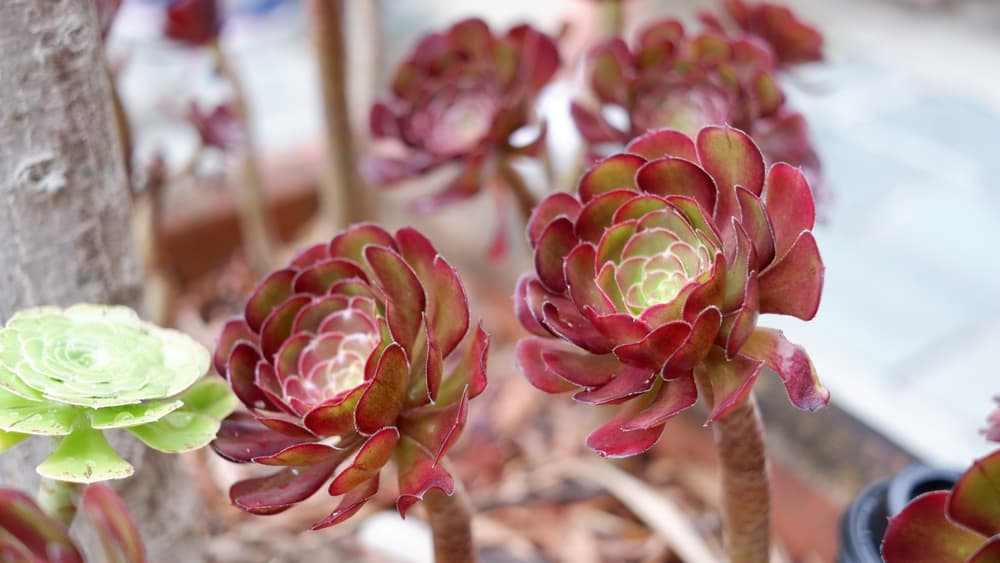
“We entered our own Aeonium ‘Jubilee’ into the RHS Plant of the year competition at the Chelsea Flower Show last year and were finalists!
“The Queen even bought a few for her own garden in Sandringham. It was a real highlight and a proud moment for us.”
Other Aeonium lovers, Tom Adkin and Giulia Consolandi discuss why they love this succulent:
“Anything in the aeonium family is our favourite, as these plants have such a wide variety of colour, hybrids and variety of structure that make them fantastic plants.
“They can also be outside for most of the year, but will need winter protection depending on where you are.
“We simply put them in our tunnels over winter, keep them dry and fleece them when frost or very low temperatures are due.”
Peter Bint, Society Secretary from the British Cactus and Succulent Society, finds it hard to pick a favourite.
“Favourite plants are a movable feast and can vary month by month,” he shares.

“Some people like to grow small-growing plants, whilst others like the challenge of finding plants they can grow permanently in their garden. Then, some people discover African succulents and that’s it for them.
“There are caudiciform plants that provide a challenge. Exposing their tuberous roots exposes a completely different beauty. Some grow in spring and summer, but there are some, like Dioscuri, that you cannot be sure when they will be growing.
“I’ve had specimens that start to grow in August and don’t stop till the following April. Others might wait til October to start.”
So, what is Peter’s current favourite succulent?
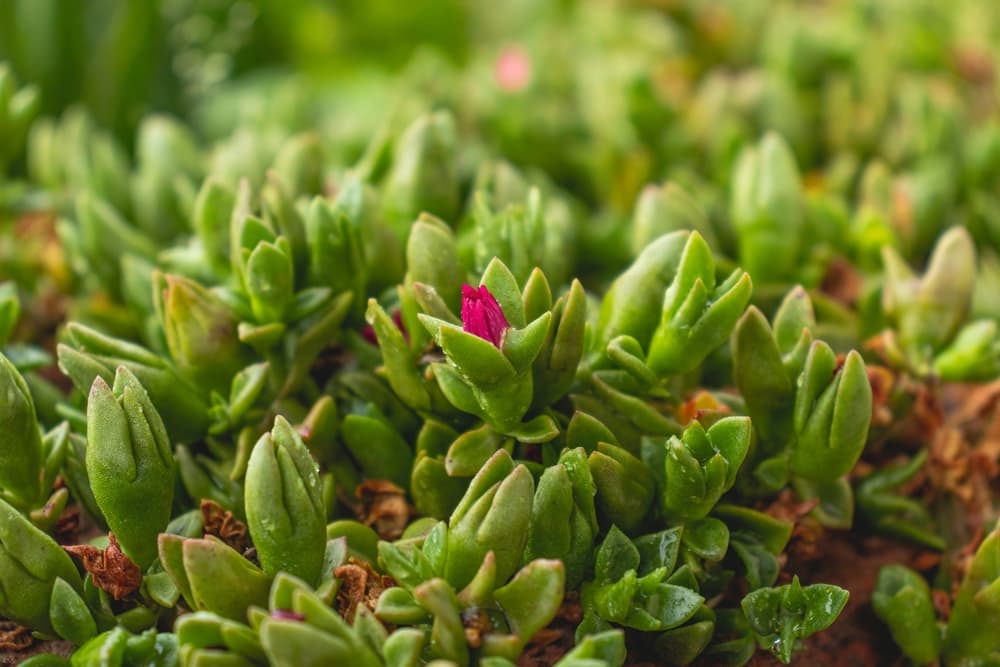
“My present joy is the Aizoaceae family, as it is truly fascinating,” shares Peter.
Niamh Mullally is the Owner of Southwold Succulent Co and has been growing succulents for over 20 years.
“One of my favourites is Delosperma ‘Fire Wonder’, which is from the Wheels of Wonder series,” Niamh shares.

“This succulent originates from Japan and is used there on green roofs for the maximum flowering period. It is drought-tolerant and low-maintenance.
“Masses of deep orange daisies from May to the first frosts are a sight to behold and keep our bees fed all summer long.”
From the Tucson Cactus And Succulent Society, Richard Wiedhopf is less conclusive about his favourite type of succulent:
“I’ve never met a succulent plant I didn’t like.

“My favourite succulents are the ones that grow to maturity and flower. It is the only real proof of success and gives me a feeling of real accomplishment.”
If, like Richard, you’re still unsure what your favourite might be, don’t worry – we have a longer list of options for you below.
About Our List
First of all, the list below is a list of only succulents, and we have chosen (to narrow things down) not to include cacti and bromeliads.
These are sometimes classified as succulents – but some horticultural experts prefer to place them in different categories.
If you are looking for low-maintenance plants, these other categories could also be excellent plants to consider.
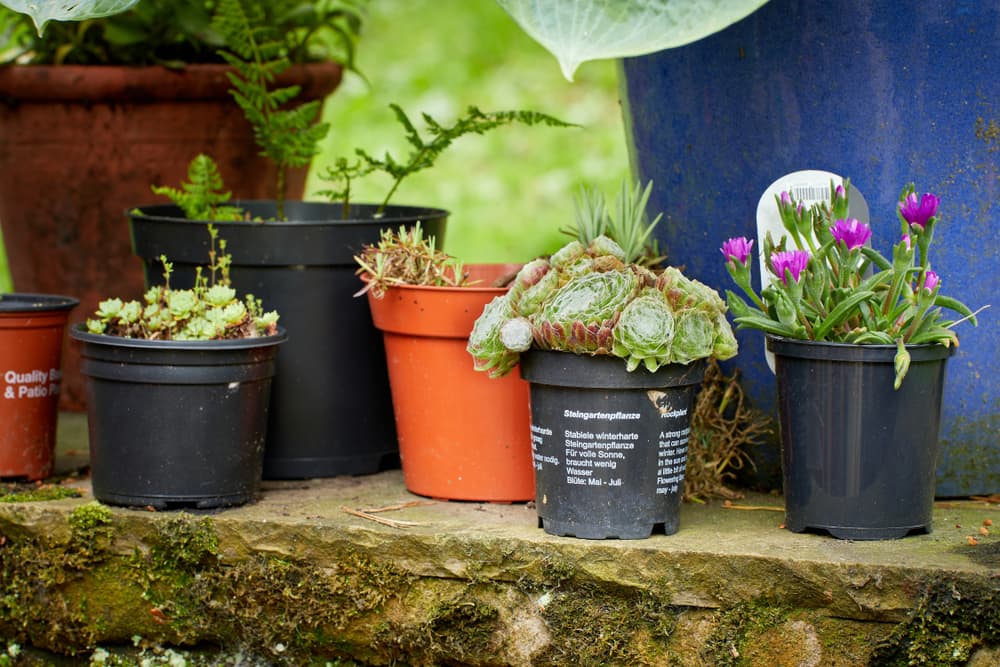
One other thing to mention is that only some of the plants in the list below will be suitable for growing outdoors in the UK.
When choosing a succulent, be sure to take into account whether you will be growing indoors or out, and the needs of the particular plant you are considering.
Remember, while succulents all share certain characteristics (especially drought tolerance) they come from often very different areas, and their other requirements can differ considerably.
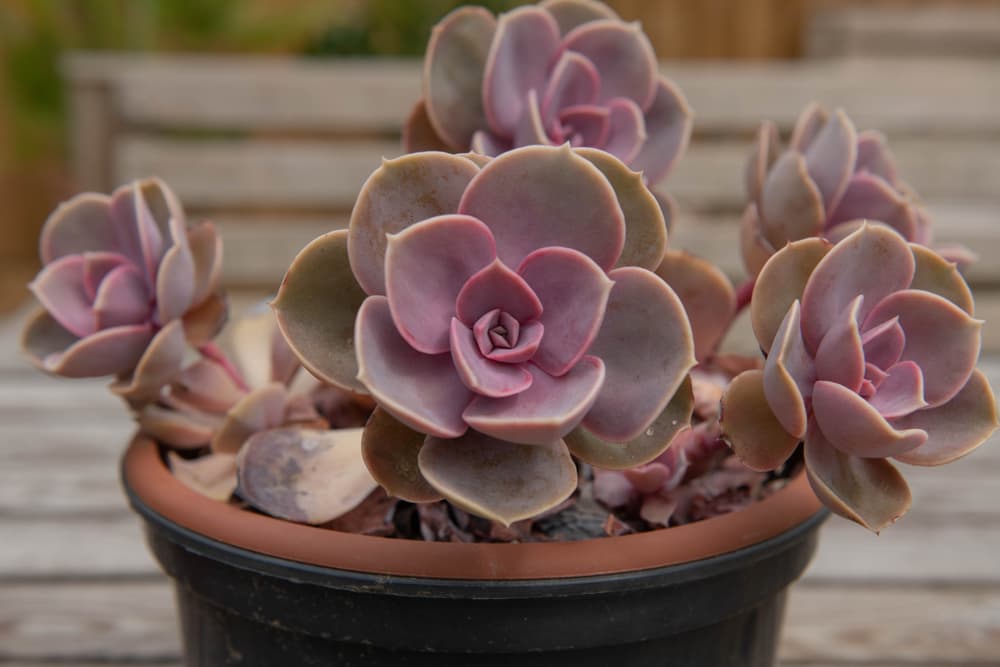
Discovering the characteristics of climate and terrain within a succulent’s typical native range can help you work out what it will need in terms of environmental conditions.
We’ve listed the succulent options under various genus’ of succulent plants, but there are several great options within some of these categories.
Without further ado then, let’s take a look at some of the succulents you could grow:
1) Sedums

- GENUS SIZE: ~600 Species
- HARDINESS RATING: H7
- TYPICALLY GROWN: OUTDOORS
- PREFERRED ASPECT: FULL SUN
- WATERING: INFREQUENT
Sedums are common succulents, used both as houseplants and for outdoor gardens in the UK.
There are a huge range of sedums to choose from, all of which can be great for edging a dry bed or border, using in a rock garden or wall, or in the creation of a drought-tolerant green roof.
Consider, for example:
S. dasyphyllum

S. album
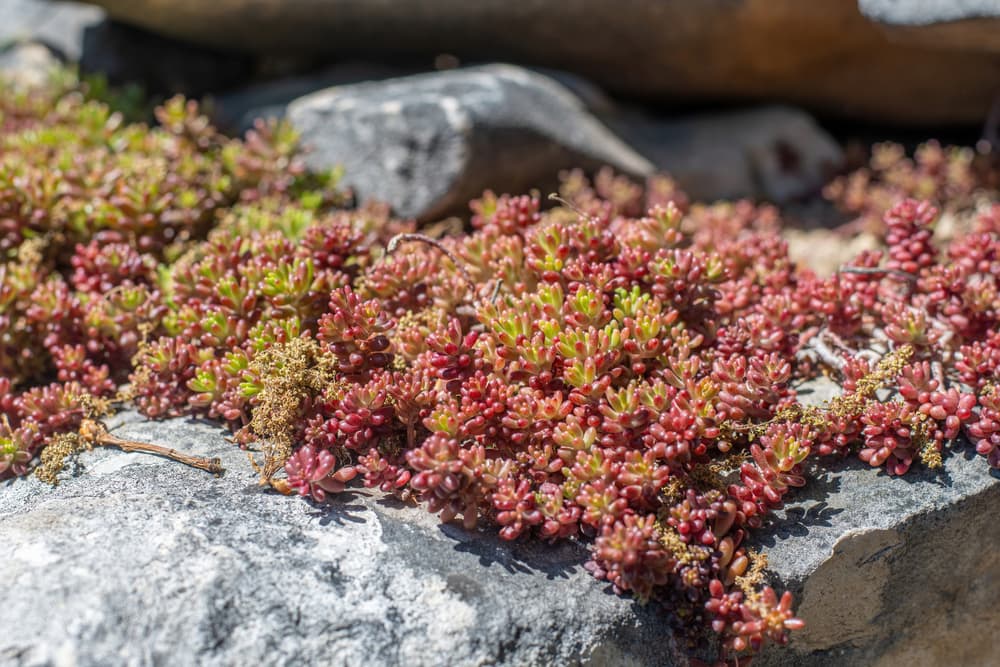
S. acre

S. reflexum
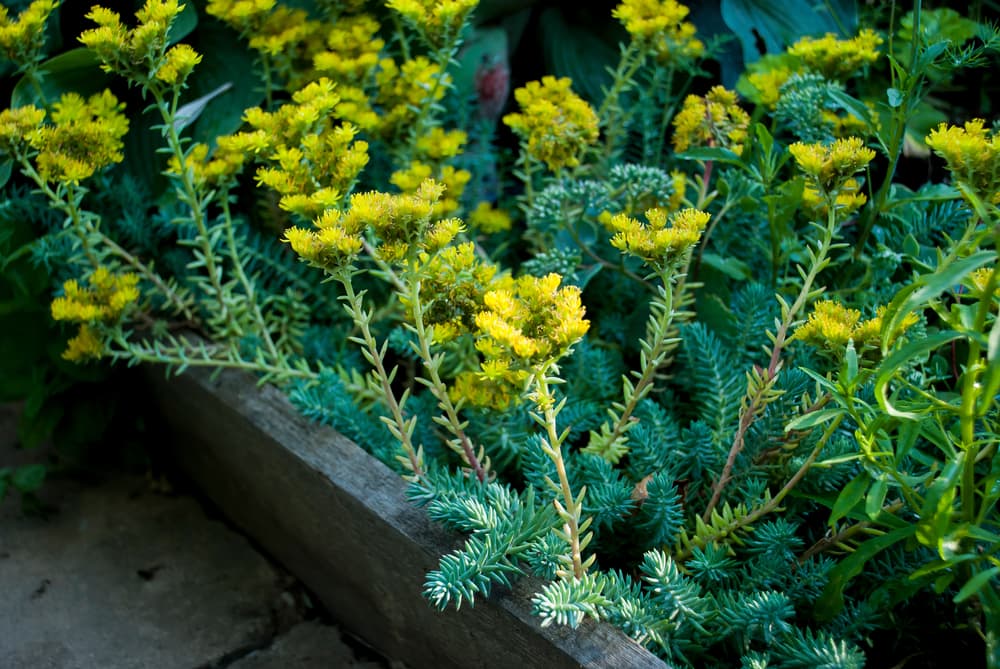
One other succulent not included on this list but also worth thinking about is purslane.
Purslane

Purslane is often viewed as a common weed, but this is a succulent rather similar to sedums, with similar benefits.
What you might not know is that purslane (Portulaca oleracea) is also an edible plant.1Palsdottir, H. (2017, June 16). Purslane – A Tasty “Weed” That is Loaded With Nutrients. Healthline. Retrieved March 24, 2023, from https://www.healthline.com/nutrition/purslane
So it is well worthwhile giving this ‘weed’ some space in your garden.
2) Sempervivums

- GENUS SIZE: ~30 Species
- HARDINESS RATING: H7
- TYPICALLY GROWN: INDOORS OR OUTDOORS
- PREFERRED ASPECT: FULL SUN
- WATERING: INFREQUENT INDOORS; NOT REQUIRED OUTDOORS
Like sedums, there is a wide range of sempervivums that can be grown outdoors in suitable conditions.
These are another type of succulent which are excellent for the creation of low-maintenance planting schemes, bed edging or green roofs.
3) Senecio

- GENUS SIZE: ~1,400 Species
- HARDINESS RATING: TYPICALLY H4-H5
- TYPICALLY GROWN: INDOORS OR OUTDOORS
- PREFERRED ASPECT: FULL SUN
- WATERING: INFREQUENT INDOORS; NOT REQUIRED OUTDOORS
Senecio rowleyanus (commonly known as the ‘String of Beads’ plant), is a well-known houseplant and a great houseplant succulent to consider here in the UK.
Its strings of modified succulent leaves really do look like strings of green beads, and these plants look especially good in hanging containers which show the trailing stems off to full advantage.
Other Senecios can also make good houseplants – such as, for example, S. serpens and S. radicans.
S. serpens

S. radicans

4) Aeonium

- GENUS SIZE: ~40 Species
- HARDINESS RATING: H1C
- TYPICALLY GROWN: INDOORS
- PREFERRED ASPECT: FULL SUN
- WATERING: INFREQUENT
Aeoniums can be show-off succulents with a range of interesting colours and forms.2Lachelin, L. (n.d.-a). Aeonium species. Oxford University Plants. Retrieved March 24, 2023, from https://herbaria.plants.ox.ac.uk/bol/plants400/Profiles/ab/Aeonium
One dramatic option is Aeonium ‘Zwartkop’ which is a shrubby plant with rosettes of shiny succulent leaves that are lime green in the middle and redding, purplish, almost black to the outer sides.
A. ‘Zwartkop’

You can grow it in a pot or a sunny border outside in summer.
Aeonium arboreum is another attractive option which is also known as the ‘Irish Rose’.
A. arboreum

5) Echeveria

- GENUS SIZE: ~150 Species
- HARDINESS RATING: TYPICALLY H2
- TYPICALLY GROWN: INDOORS
- PREFERRED ASPECT: FULL SUN
- WATERING: INFREQUENT
Echeveria elegans (pictured above) is just one example of an excellent succulent within this group.
Most commonly, this plant, which is also called ‘Mexican snowball’ is grown as a houseplant.
It can also be used in summer bedding displays before it is brought indoors over the winter months.
These attractive succulents come in a wide variety – they flower in summer but are mostly known for their amazing foliage.3The Editors of Encyclopaedia Britannica. (1999d, July 23). Echeveria | Description, Major Species, & Facts. Encyclopedia Britannica. Retrieved March 24, 2023, from https://www.britannica.com/plant/Echeveria
Echeveria ‘Blue Frills’ is one very attractive cultivar to consider.
E. ‘Blue Frills’

6) Aloe

- GENUS SIZE: ~400-600 Species
- HARDINESS RATING: VARIES
- TYPICALLY GROWN: INDOORS OR OUTDOORS
- PREFERRED ASPECT: Typically Full Sun; Some Will Burn (Turn Red) In Direct Sun
- WATERING: INFREQUENT
A wide range of Aloes can work very well for UK growers, but they do need to be kept frost-free over the winter months.
One of the most common (and useful) options is Aloe vera.
It is most commonly grown as a houseplant but can also potentially be kept in a polytunnel or greenhouse.
Aloe vera is a useful houseplant to grow because it can provide a yield of gel for multiple purposes.4Chandegara, V., & Kumar Varshney, A. (2012, December). Aloe vera: Development of gel extraction process for Aloe vera leaves. Research Gate. Retrieved March 24, 2023, from https://www.researchgate.net/publication/274315362_Aloe_vera_Development_of_gel_extraction_process_for_Aloe_vera_leaves
Other aloes to grow include Aloe rauhii and Aloe aristata.
A. rauhii

A. aristata

The latter is also potentially suitable for growing outdoors as it is a much hardier type.
7) Agave

- GENUS SIZE: ~200 Species
- HARDINESS RATING: H2
- TYPICALLY GROWN: INDOORS
- PREFERRED ASPECT: FULL SUN
- WATERING: INFREQUENT
Though it is native to parts of the South-Western US and Mexico, Agave americana can be a good choice for a southern UK garden.
As long as it is in a relatively low-rainfall area, it can potentially be grown outdoors in well-draining soil all year round.
In most parts of the UK, however, this plant is better for indoors growing – at least over the winter months.
8) Crassula

- GENUS SIZE: ~200 Species
- HARDINESS RATING: H2
- TYPICALLY GROWN: INDOORS
- PREFERRED ASPECT: FULL SUN / PART SHADE
- WATERING: INFREQUENT
The ‘Jade Tree’, Crassula ovata is another great choice, though really only as a houseplant.
This plant is also sometimes known as ‘friendship tree’, ‘money plant’ or lucky plant’.
It is one of the few succulents that can cope with a little shade, so can cope inside a room with a little less bright light.
Two interesting cultivars are ‘Gollum’ with its thin, tubular leaves, and ‘Hobbit’ which has larger leaves with a less tubular appearance.
C. ovata ‘Hobbit’

Another interesting Crassula is C. marnieriana which is another great houseplant.
C. marnieriana

It has long graceful stems that look kind of like caterpillars, and ivory-coloured flowers.
9) Pachyphytum

- GENUS SIZE: ~30 Species
- HARDINESS RATING: H2
- TYPICALLY GROWN: INDOORS
- PREFERRED ASPECT: PART SHADE
- WATERING: INFREQUENT
Pachyphytum is a fleshy succulent with large chalk-dusted leaves that look a little like stones.
This is another good succulent to grow as a houseplant in homes that are a little less bright and sunny, as it can cope with partial to full shade.
10) Gasteria

- GENUS SIZE: ~130 Species
- HARDINESS RATING: H2
- TYPICALLY GROWN: INDOORS
- PREFERRED ASPECT: PART SHADE
- WATERING: RARELY
Gasteria batesiana is another interesting succulent to consider growing indoors.
It has rough, pointy succulent leaves that grow close together forming dense clumps of offsets.
If you have one of these plants, it is easy to propagate to make more.
11) Faucaria

- GENUS SIZE: ~30 Species
- HARDINESS RATING: H2
- TYPICALLY GROWN: INDOORS
- PREFERRED ASPECT: FULL SUN
- WATERING: INFREQUENT
Faucaria tigrina, known as ‘Tiger’s Jaw’ has small green leaves with spikes along the edges that make them look, as the name suggests, like tiny tiger’s jaws.
When well cared for they can also produce yellow flowers in the autumn.
12) Graptopetalum

- GENUS SIZE: ~25 Species
- HARDINESS RATING: H2
- TYPICALLY GROWN: INDOORS
- PREFERRED ASPECT: FULL SUN
- WATERING: INFREQUENT
The stunning Graptopetalum superbum has amazing panicles of flowers as well as attractive purple, frosted foliage.
This subspecies is hardy to -3°C, so it can be grown outdoors all year round in milder regions.
13) Graptoveria

- GENUS SIZE: ~20 Species
- HARDINESS RATING: H4
- TYPICALLY GROWN: INDOORS
- PREFERRED ASPECT: FULL SUN
- WATERING: INFREQUENT
Some Graptopetalum have been bred with echeverias to produce hybrid plants known as Graptoverias.
‘Fred Ives’ has dense purple and pinkish-tinged leaves and when left out in the sun, the leaves can change colour and turn a range of different shades.
G. ‘Fred Ives’

Yellow flowers sometimes bloom in the summer months.
14) Haworthia

- GENUS SIZE: ~40 Species
- HARDINESS RATING: H2
- TYPICALLY GROWN: INDOORS / OUTDOORS IN SUMMER
- PREFERRED ASPECT: FULL LIGHT; AVOID DIRECT SUN
- WATERING: INFREQUENT
There are a number of Haworthia succulents to consider for houseplants, or for growing in a summer garden in the UK.
Haworthia fasciata is one spectacular example within this species to consider.
H. fasciata

It is a small, half-hardy succulent that is drought tolerant.
In the UK, it can be ideal for planting outside during the summer and bringing undercover during the winter months.
15) Lithops

- GENUS SIZE: ~40 Species
- HARDINESS RATING: H2
- TYPICALLY GROWN: INDOORS
- PREFERRED ASPECT: FULL SUN
- WATERING: INFREQUENT
The more you learn about succulents, the more you will learn about the weird and wonderful forms in which they come.
Lithops (living stones) are perhaps one of the weirdest.
Native to the harsh sunny climes of South Africa, these small plants really do look like stones.
They need plenty of sun, so put them on a south-facing windowsill and they will slowly grow to form small clusters of colourful pebble-like plants.
16) Kalanchoe

- GENUS SIZE: ~125 Species
- HARDINESS RATING: H1B
- TYPICALLY GROWN: INDOORS
- PREFERRED ASPECT: PART SHADE
- WATERING: INFREQUENT
If you are looking for a succulent that offers flowers as well as intriguing foliage then you cannot do better than Kalanchoe blossfeldiana.
K. blossfeldiana

Flaming Katy can bloom for weeks on end and can have blooms in a wide variety of different hues.
There are also plenty of other types of Kalanchoe to consider.
These are, as mentioned above, just a small fraction of the many succulents you could consider, especially if you are growing them indoors in the UK.
Most are relatively easy to care for and won’t take a lot of time to tend.
They can also allow you to experience the wonderful world of exotic plants from around the world in your very own home.
If you don’t already grow succulents, now is a good time to start!
References
- 1Palsdottir, H. (2017, June 16). Purslane – A Tasty “Weed” That is Loaded With Nutrients. Healthline. Retrieved March 24, 2023, from https://www.healthline.com/nutrition/purslane
- 2Lachelin, L. (n.d.-a). Aeonium species. Oxford University Plants. Retrieved March 24, 2023, from https://herbaria.plants.ox.ac.uk/bol/plants400/Profiles/ab/Aeonium
- 3The Editors of Encyclopaedia Britannica. (1999d, July 23). Echeveria | Description, Major Species, & Facts. Encyclopedia Britannica. Retrieved March 24, 2023, from https://www.britannica.com/plant/Echeveria
- 4Chandegara, V., & Kumar Varshney, A. (2012, December). Aloe vera: Development of gel extraction process for Aloe vera leaves. Research Gate. Retrieved March 24, 2023, from https://www.researchgate.net/publication/274315362_Aloe_vera_Development_of_gel_extraction_process_for_Aloe_vera_leaves

